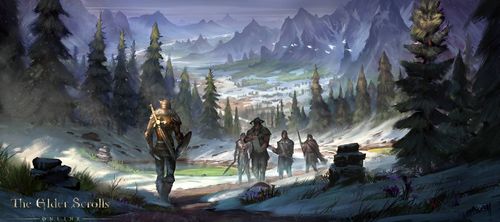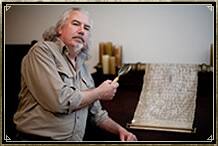General:Reading the Future of the Past in the Elder Scrolls
Originally published October 18, 2012. The original article can be found here.
Loremaster Lawrence Schick spends his time creating and breathing life into the deep history and lore at the heart of The Elder Scrolls Online. In our first of many behind-the-scenes developer articles, Lawrence shares with us some of his experiences as our Loremaster, including what it's like to write new history within the Second Era and why we chose that time period for ESO's setting. He also explains his approach to weaving ESO's story into Tamriel's existing saga, and discusses the careful collaborative effort we've shared with Bethesda Softworks Team to ensure lore consistency in ESO.
I'm a writer on ESO, as well as the Lead Loremaster, which means I'm responsible for making sure The Elder Scrolls Online lives up to its name. As I'm sure you're aware, the world of the Elder Scrolls has a rich history that's been developed by a lot of talented designers at Bethesda Game Studios over the last twenty years. ESO has to honor and adhere to that legacy, while at the same time expanding upon it.
ESO is not a sequel to The Elder Scrolls V: Skyrim, or any of the other single-player games in the series – in fact, it's set almost a thousand years before the events of Skyrim. Why did we do that?
First of all, it's so we're not treading on Bethesda Game Studios' heels. BGS needs the leeway to continue their amazing series of single-player games without getting boxed in by or tangled up with ESO's storylines. By setting our game in the series' distant past, we avoid placing constraints on future BGS titles.
More importantly, from our standpoint, is that ESO is a multi-player game, and games with lots of heroes traveling around doing heroic stuff work best when set in times of turmoil. In periods of peace and stability heroic adventurers are really kind of a nuisance, but in times of trouble people need their help and are happy to have them around.
So for a setting we needed to pick a time of turmoil in Elder Scrolls long history– but not one that would be too far back, because we wanted to have the iconic and recognizable Tamrielic cultures everyone knows and loves from the single-player series. Given those criteria, one period jumped right off the timeline at us: the Interregnum, that period in Elder Scrolls Second Era between the fall of the Reman Empire and the rise of Tiber Septim and the Third Empire.
The Interregnum is perfect: the nine classical provinces of the Empire exist as established under Reman, and the cultures of their inhabitants have evolved enough to become the ones we're familiar with. However, in between the Second and Third Empires there's no strong central authority in Tamriel, and each race has the freedom to choose its own destiny. The "Emperors" who sit on the Ruby Throne have no power beyond the bounds of the central province of Cyrodiil, and often not even beyond the walls of the Imperial City. Most of these Emperors have reigns so brief their names aren't even recorded in history.
Other familiar institutions we wanted are in place by this period: the Mages Guild and Fighters Guild were both established early in the Second Era, the Dark Brotherhood first appeared around the same time, and the regional Thieves Guilds are just starting to link up. The living gods of the Tribunal rule the Dark Elves in Morrowind, the Khajiiti (Cat-Men) kingdoms have united to form Elsweyr, and we have the foundation of the first Aldmeri Dominion, one of the few times in history when the High Elves of Summerset open their borders to outsiders.
Our task, then, is to recreate the world of Tamriel as it existed in the year 2E 583, as established in existing Elder Scrolls lore, but showing you these cultures and institutions when they were still rough-hewn and new. We're also bringing you parts of Tamriel that have never been shown before, taking you to people and places that have previously only been hinted at.
So how do we do all this and make sure we get it right? First and foremost, of course, by having the full cooperation of the original loremasters at Bethesda Game Studios. Todd Howard and his team have been great, generous with their time and always forthcoming in their answers to the many questions I fling at them. And I've had access to their internal design documents, which has given me insights into how they view Tamriel beyond the material in the published games.
Second, and also very important: we treat the history of Tamriel as if it were just as solid and real as Earth history. I've worked on my share of fantasy games, certainly, but I've done even more in historical settings, so I simply applied my years of experience doing historical research to understanding the history and cultures of Tamriel. Having a strong feel for real history enables me to help our team fill in the gaps in Tamriel's history with characters and events that ring true to both worlds.
Here at ZeniMax Online I work closely with the content teams on characters, story, and dialogue to ensure consistency with the Elder Scrolls world and tone, and to help flesh out new lore that fits comfortably with the old. I consult on a daily basis with the Concept group in the Art department about the environments, cultures, and creatures of Tamriel, and with the Audio team about regional accents, dialects, and pronunciation for all the spoken dialogue in the game.
And then there's the Elder Scrolls Lore Library – but I believe we'll leave that for another time!




